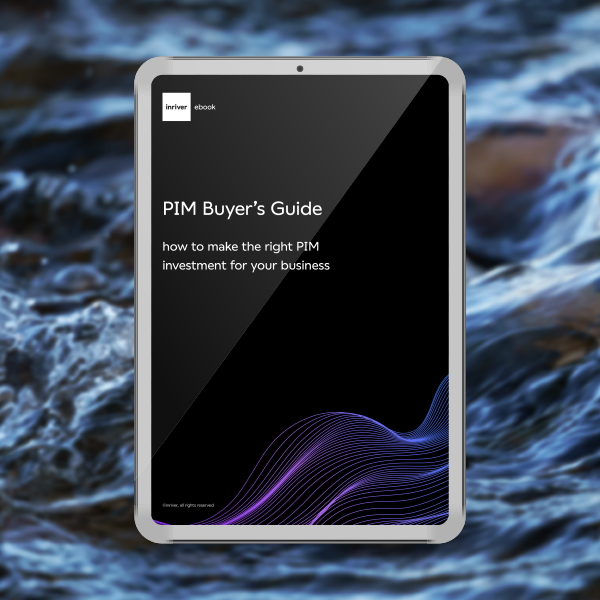PIM implementation: The complete how-to guide
ensure a soft landing for your PIM journey
Product Information Management software turns product data into a profit-making asset, and to get the most from this journey, it’s essential the implementation is done right.
What if your product information could become a tool to fuel business growth? Think enhanced profitability at every touchpoint. Effortless expansion into new markets and channels. Your digital shelf thriving across the omnichannel landscape.
As many businesses already know, these are just a few of the possibilities unlocked by a Product Information Management (PIM) solution. However, if PIM integration is not executed correctly, your product data could remain inaccurate, inconsistent, and ineffective.
That is where a well-structured PIM implementation process comes in.
A successful PIM implementation process covers all the bases: configuration, migration, integration, KPI establishment, and data modeling. When done right, PIM implementation allows brands, manufacturers, and retailers to maximize the full value of their product data, transforming previously disjointed data into seamless omnichannel experiences.
Personnel involved in PIM implementation
Hint: It’s not just your IT team.
Total organizational buy-in and involvement is an essential first step to successful PIM implementation.
To implement a system designed to centralize product data for the entire organization to use, you need to get the entire organization on board. That means agreeing upon the solution with key department leaders, making sure executives understand the value, and building documentation for employees on what implementation and usage will look like.

Creating a PIM implementation plan
Just as a PIM solution is a master of data management, you and your team must be master organizers when approaching your comprehensive PIM implementation plan.
Build these steps into your implementation plan to ensure it runs smoothly:
Configuration
The initial stage is a collaborative effort between you and your PIM vendor to configure the workflow and system to your specific requirements. This involves mapping out how the data will flow, from what source, and who is authorized to update and access it.
You’ll also identify desired tech-stack integrations, globalization, and language requirements, and any necessary customizations. Discussions at this key phase set the tone for how the PIM system will be structured and used within your organization.
Migration
This is when you collect all the product data living in your business systems and files to be transferred into your PIM. This involves a comprehensive audit of existing data, performing any data cleansing necessary for accuracy, mapping the data to the correct fields in the PIM, uploading the data, and performing a final quality audit.
Depending on the amount of data you’re migrating and other factors, some businesses choose to migrate in batches, while others may prefer to handle it in one fell swoop.
Integration
With data mapped and migrated, this stage synchronizes and paves the way for the PIM software to act as the single source of data truth across all systems. Extensive system testing is done in this stage to ensure the PIM system works to meet the business’s goals. It’s also when user training typically starts, preparing teams for a smooth transition to the new software.

Measurement
Another key stage to a successful PIM integration is setting KPIs to measure the PIM’s performance. You’ll decide what to measure against your goals and objectives to understand the continuous value PIM is bringing to your organization. This can include data accuracy rates, speed of updates, time to market, internal efficiencies, internal adoption rates, and metrics related to customer satisfaction.
Data modeling
All brands, manufacturers, and retailers have specific needs when it comes to structuring a PIM data model. What data relationships and attributes are most common? Which products should be grouped together, and just how granular does their organization need to be? This phase is where PIM implementation is customized to fit your specific product data—and your plans to grow that data as business scales.
Overcoming PIM implementation challenges
With a process so all-encompassing of so much data and so many moving parts, it’s not without its potential challenges. With careful planning and a supportive implementation partner, you can overcome them before they arise.
- Data inaccuracies: One of the most common hurdles of any PIM implementation is data inaccuracies. Many organizations underestimate how much of their data is indeed outdated, duplicated, or incorrect from other business or legacy systems. To overcome this, the importance of a thorough data quality audit before the migration cannot be overstated.
- Managing onboarding processes: While the entire company might not gain access to the PIM until the later stages, roles and responsibilities should be considered during or before the configuration stage. Not only do key users and stakeholders need to be educated on how to use the PIM tool, but many of them may want to add their input on how it should function to get the most out of it.
- Handling complexity: In the thick of a PIM implementation, it can feel like a lot going on—especially if you don’t have a clear vision, plan, and dedicated leaders driving your momentum. Additionally, it’s important to strike a balance between following your comprehensive plan, and not expecting end-all perfection at the expense of progress. If the data is 95% accurate, keep moving forward. Your PIM will help you fix those errors later.

How to ensure a successful PIM journey
Along with accounting for the crucial steps of an implementation plan and avoiding common pitfalls, there are a few pro tips our implementation experts have gathered over the years on what makes a PIM implementation most successful.
- Align your business objectives with outcome goals: What do you want your PIM tools to achieve for your business? What do you want your business to achieve, period? Are these ideas aligned? Think about how your PIM can work toward your business objectives. At the same time, remember that a PIM isn’t designed to do everything—so set realistic and achievable expectations.
- Implement your PIM for long-term success. An advanced PIM solution is built on a fully extensible data model that scales with your business needs. But this is not the only way a PIM can prime you for long-term success. A well-implemented PIM creates an adaptable foundation for your entire tech stack. With PIM, you can start thinking about future growth, and what additional functionality, resources, and support might your team need for your PIM to add even more value over time.
- Conduct thorough testing: In the PIM implementations that are delayed or unsuccessful, a common problem is that there was a lack of thorough testing throughout the implementation. From preliminary data auditing to user testing from different departmental perspectives, testing is one of your most valuable assets to understanding how your PIM becomes successful in your organization.
- Maintaining continuity in PIM operations: The data models, configurations, and rulesets you establish in your PIM implementation framework should be carried through the system consistently. If product data lacks organization and continuity, it becomes harder for teams to use, leaving valuable product data untapped.
Why should you consider implementing a PIM system?
Brands, manufacturers, retailers, and any enterprise dealing with product data can benefit from a PIM. From internal team efficiencies to happier customers, and everything in between, the advantages of adopting a PIM system are felt virtually everywhere.
Enhancing data accuracy
The implementation of your PIM is only the beginning of better product data. With a PIM in place, you’ll receive automated workflows, regular reminders, and helpful suggestions on how to enrich and update your product data regularly. With advanced PIM solutions that have integrated digital shelf analytics technology, real-time data migration from your digital shelf flows back into the PIM, so your data remains relevant to the most recent customer behavior.

Streamlining data sharing and processes
The PIM platform acts as a master of data migration, organizing, translating, and dispersing product information wherever it’s needed. It enhances collaboration, allowing for efficient workflows with suppliers, partners, and agencies. This streamlined process also means you can update and enrich product information quickly, keeping your customers informed.
Building business efficiencies
A PIM can unlock efficiencies in all corners of an organization. For example, automatically translate product information across regions to reduce manual efforts and enter new markets faster. Accelerate compliance protocols with built-in regulatory intelligence that helps keep your data compliant with the latest requirements.
inriver: PIM implementation made easy
Implementing a PIM system is the first step toward tapping into the hidden value of your product data. By accounting for key implementation areas, planning carefully, and avoiding common mistakes, you’ll be well on your way to limitless value.
Inriver makes PIM implementations easy. With expert-built architecture designed to cater to your unique business goals, you need only tell our implementation specialists your vision—and they’ll lead the way.
With inriver, you’re not alone in carving out your implementation plan. We have teams of experts who work alongside you, from configuration to onboarding and beyond. We also have the support staff and resources you need to maintain your PIM solution long after your PIM implementation process is over.
Learn more about how you can start harnessing the power of product information to drive engagement, enhance customer experience, and fuel growth. Talk to an inriver expert or book a live demo today.
want to see the inriver PIM in action?
Schedule a personalized, guided demo with an inriver expert today to see how the inriver PIM can get more value from your product information.
you may also like…
frequently asked questions
what is PIM implementation?
PIM implementation is a multi-step process that starts with building a customized implementation plan and concludes with the successful launch of PIM software as part of your organization’s tech stack.
what does a PIM do?
A Product Information Management (PIM) system centralizes an organization’s product data in one single source of truth and allows for that product data to be enriched, dispersed, syndicated, and analyzed to better serve teams and customers.
